Lactate Testing and Cycling
Team LottoNL and BORA-hansgrohe
Sebastian Weber presented his analytical approach to the testing and training of cyclists in San Francisco on August 22, 2016 and returned to the US in May.
- Founding and growing Germany's biggest coaching business. In 2006 Sebastian founded the STAPS human performance lab and coaching business. STAPS now employs 8 full time coaches and just opens it 3rd facility. 80% of new customers who ever walk in subscribe to regular service and become regular customers, drastically reducing the need for new recruitments.
- The metabolic origin of the anaerobic threshold. It is one of cycling most used terms when it comes to endurance performance and the most important benchmark value. However, most people do not understand what it is and why it even exists. If we understand why it exists, how it is created we are able to change it!
- Tweaking nutrition for specific training purposes. Tuning nutrition to a specific workout has become popular in sport science research over the past decade. A lot of the mechanisms to either enhance or hamper training adaptation by nutrition have been explored. We will talk about how to deploy that knowledge and implement such techniques into a training program so that it actually works in real life applications.
- Athlete profiling - beyond critical power testing. Critical power testing has become the most important tool for benchmarking athletes performance in training and competition. However there is more to it then just the pure number. Playing it smart, CP testing can give insights into the metabolic profile of an athlete, his muscle fiber spectrum and even what training might be most beneficial for him/her.
- Glycolytic capacity – the unnoticed game changer in endurance performance. It might be the least known parameter for most athletes and coaches. However glycolytic capacity can influence everything that is important to a cyclist; fat metabolism, threshold power, recovery, carbohydrate sparing, stamina. It is often the main differentiator between a good and an excellent cyclist and between amateur and professional. Working with this parameter in training and monitoring helped multiple athletes win world championships– not only in cycling but also in swimming & ironman triathlon.
(examples of how glycolytic capacity affects race performance are discussed below.)
Sebastian has developed software based on the ideas of Alois Mader. This software is currently being used with swimming and cycling federations in Europe and hopefully will be available for any coach in the next few months.
Several of Sebastian's ideas are discussed below. For more information on the new software, STAPS and Sebastian's ideas use the following links:
The STAPS story: Germanys most successful testing & coaching business
Sebastian's website
New Sofware available in 2017
See interview about his experience with HTC Columbia below
The Importance of Lactate Testing
The reason lactate is different from every other variable a coach and athlete can measure is twofold.
- First - there exist an effort level called the maximal lactate steady state that an athlete can continue at without having to slow down for an extended period of time, usually an hour but sometimes longer. As long as the athlete maintains this effort level the lactate level will remain constant. At small effort levels above this point the athlete's lactate level will rise slowly and he or she will be forced to stop, sometimes within a few minutes or sometimes after an extended period of 20-30 minutes. Above this maximal lactate steady state (abbreviated MLSS or MaxLass) there are no more steady states, but a slow and frequently rapid progression to exhaustion. Interesting, but why is this important?
- Second - the maximal lactate steady state is the single best indicator of endurance performance known. Generally the athlete with the higher maximal lactate steady state will be faster in an endurance event. Increases in the maximal lactate steady state are almost always accompanied by improvements in race performance for endurance events. So the lactate response curve is usually the best measure of potential race performance for endurance events. It is also generally the best indicator of improvements in training. For short events the maximal lactate steady state is also highly correlated with performance, but anaerobic capacity or the ability to produce lactate and speed will become more important as the event get shorter*.
So lactate is a measure of how well you will do in an endurance race and how well your training has progressed. It will also allow the coach or the athlete to set training paces.
*For short events such as swimming, middle distance running, rowing, speed skating, and track cycling, it is sometimes possible to be too fast. The body's tendency to produce too much lactate will actually cause the athlete to slow down in these short races. An ex-swimmer once told us, he could beat everyone at 50m but would be only good at 100m and would not enter a 200m race because he was so slow. The Secrets of Lactate CD-ROM covers these topics in detail.
Are There Other Measures Besides Lactate?
But are there other ways to measure the maximal lactate steady state besides lactate testing? Do I have to do lactate testing? Before we start we want to emphasize two facts about lactate which make it uniquely relevant to performance in a cycling race.
- First, lactate is produced by the anaerobic system. The anaerobic system uses glucose as its fuel (glucose is stored in the muscles as chain of glucose molecules which is called glycogen so glucose and glycogen are the same thing). When glucose is broken down by the anaerobic system it is essentially split in half releasing very quick energy in the process. It creates lactate and hydrogen ions. So lactate is the product of using glucose for energy**.
This lactate molecule is then used for fuel by the aerobic system. The lactate molecule is converted to pyruvate and enters the aerobic system. The aerobic system also produces a lot of energy, but at a slower rate than the anaerobic system. The lactate/pyruvate is broken down into water and carbon dioxide. These are harmless to the body.
Thus, lactate is related to both the aerobic and anaerobic systems and proper testing can measure the strength of both systems. And today these tests are easy and inexpensive. Heart rates, time trials, perceived effort, maximum power will not tell you this information. VO2 max testing in a laboratory will provide much of this information but even these $25,000 machines lack the precision of a good lactate test on some measures.
- Second, lactate tests predict performance better than any other marker of metabolic activity. We have mentioned the maximal lactate steady state test, but there are several other protocols to measure lactate that are much easier and just as accurate at predicting success in an endurance race as the MLSS test. All these tests identify an effort level that correlates highly with performance. For cycling, the effort level is most frequently expressed in watts or the power generated at the MLSS. If body weight is calculated, the effort level is often expressed in watts per kilogram because this is be an indicator of how well the cyclist will do on climbs (see analysis below on this.) But for a straight time trial on relatively flat terrain the power at the MaxLass or one of these other measures is probably the better predictor.
There are several other terms used by coaches and researchers that are related to Max Lass and these often have different definitions depending upon who is using them or which book you read. The most common terms are "anaerobic threshold" and "lactate threshold." Be careful when you see these terms because they can mean different things from one article to the next. On this site, these differences are discussed in detail on our lactate threshold and threshold pages.
**The real end product of the anaerobic system is pyruvate which becomes fuel for the aerobic system. However, lactate and pyruvate are closely related and differ only by two hydrogen atoms and turn into each other rather easily in the muscle. This is a complicated process but there is no misinformation by referring to lactate as the end product of anaerobic metabolism since pyruvate is either used for aerobic metabolism or turns into lactate. For testing and training purposes, the difference is irrelevant.
Some exercise scientists have said this is nature's way of making us safer. By removing two hydrogen ions from the muscles to create lactate from pyruvate the body is making the muscles less acidic and safer.
Lactate Testing and Correct Training
Coaching is both art and science. The numerous building blocks for an optimal performance must be assembled in the right order, and must recognize that each individual is different. Some of these building blocks are correct technique, positive mental attitude and a proper diet. The cornerstone for this building is precise physiological training. That is the main reason a cyclist spends so much time on the road or on a trainer or in the weight room.
What is appropriate physiological training? It is not only volume or else those who put in the most hours/miles would be the winners. It is not only intensity or else those who pushed themselves the hardest would be the winners. It is not someone's favorite workout or else everyone would be copying the magic workout. It turns out that each individual adapts differently and any smart training plan must recognize this. It is a fact of life. Each has to find his or her own way to peak conditioning.
The physiological objective of training is to generate a higher amount of energy per unit of time for the length of the race***. This higher rate of energy production means the athlete will be able to contract the muscles necessary for racing at a faster speed. However, the athlete must be able to sustain this rate of energy production for the length of the race. All this requires proper intensity, volume and timing of the workouts and as stated above, it must be adjusted to each individual. No standardized training zones, no heart rate formulas, no magic workouts. These all assume we are made from the same "cookie cutter." You cannot use a computer training program that works just for cyclists because no such program will work well for most cyclists. It takes time, patience and a little effort but the rewards in the end are worth it. The "Steering" process described elsewhere on our site generates the road map to each individual's PR or best performance and lactate testing tells you if you made the correct turns on this road or not and prevents you from getting lost.
***There is an exception to this. If the athlete is inefficient in the race and wastes energy, a less conditioned athlete may beat him. Efficiency in using energy is called economy of movement and is discussed in more detail on our lactate threshold page.
Unique Measure
In this section we will try to de-mystify lactate testing. Hopefully, by the time you have finished you will have a much better understanding of the importance of lactate testing and why it makes the planning for a peak performance easier and the training more efficient. We will use the term "lactate" instead of "lactic acid". They are nearly the same but it is lactate that is in your body.
First, forget what you already know about lactate and why you may be interested in it. Lactate is not a waste product or harmful and is definitely not the cause of muscle soreness. It is not even the cause of the pain or discomfort you feel during intense exercise, though it is associated with the things that cause this pain. Lactate is a natural product your body needs for proper functioning. It is on your skin, in sweat, in saliva and is colorless, odorless, tasteless and harmless. Your body could not function without it.
So why should cyclists measure lactate and not some other substance or physiological process? The answer is that lactate is the unique substance in the body that allows the coach to assess the muscles' capacity for physical performance in cyclists. What does that mean? Lactate is produced by the anaerobic system and then used by the aerobic system. Thus, it is possible with proper testing during exercise to measure the development of both the aerobic and anaerobic energy systems within the muscles actually being used for cycling. There is no other way to accomplish this that is easy and inexpensive.
To win, the cyclist needs to produce the most energy per unit of time during the entire race. The more energy produced the faster one can pedal or the more power one can exert during each rotation of the pedals. Thus, a coach should be concerned with what training will enable the cyclist to produce not only a high rate of energy but the ability to sustain it for the race. Lactate testing provides the insight into accomplishing this.
But there is a caveat to this and is discussed in the following sections. Conventional lactate threshold testing will not give you aerobic and anaerobic results but only a net of the two. What you need is both individually.
Maximal Sustained Power
The following chart is a simulation of a time trial using actual power from a SRM during the race. The lactate production and levels of lactate in the muscle are based on model of metabolism developed by Alois Mader and this chart was produced by Sebastian Weber founder of STAPS.
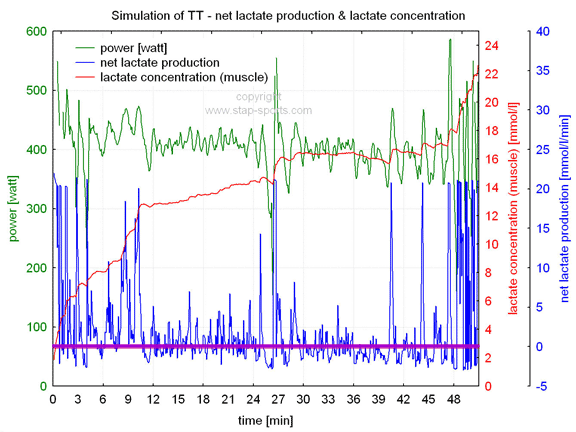
The green line shows the power fluctuations during a race. This cyclist averages about 415 watts during the first part of the race but then is forced to reduce power a little for most of the second part of the race as the lactate increases. The blue lines indicate the net lactate production during the race. When this line is below the purple line at the bottom of the chart it indicates that lactate levels are being reduced in the muscle by aerobic metabolism. The red line is the lactate level in the muscles and you can see that it is gradually increasing as the race progresses.
The muscle lactate dips occasionally as power decreases. When power drops below a certain level, some of the lactate in the muscles is used up. As the lactate in the muscles rises, the cyclists will eventually have to slow down or reduce power so that the muscle's aerobic system can eliminate some of the excess lactate. At the end of the race the lactate rises quickly as the cyclists increases power to better his time. If he had done this earlier in the race he would have been forced to slow down and would probably have an overall slower time.
It is not the lactate itself that causes the athlete to slow, it's the acid in the muscles (hydrogen ions = acid.) The excess hydrogen ions cause the pH of the muscle to go down and as it gets too low it slows muscle contraction and if it gets very low it will actually stop contraction. Lactate levels correlate well with this acidity in the muscles.
VLaMax (or glycolytic capacity)
A cyclist essentially utilizes two sources of energy during a race, the aerobic and anaerobic systems. However, to achieve both high energy production and the ability to sustain it for the entire race, the aerobic and anaerobic systems have to be developed in an optimal way. That is, they must be balanced for the event. This may seem like a strange concept to many but the following example shows what can happen if the anaerobic system is not balanced with the aerobic system.
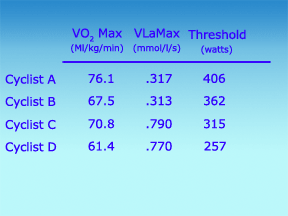
The chart above is also from data that Sebastian Weber has provided. These cyclists have widely different thresholds, ranging from 257 watts to 406 watts. Cyclist A might be able to compete in the Tour de France while Cyclists C and D can only hope to enter amateur races. Cyclist B is a professional road cyclists, yet his VO2 max is lower than Cyclist C who can only compete in amateur races. The reason is that the anaerobic system of Cyclist C is too strong and prevents him from competing at a higher level. His threshold is nearly 50 watts lower than Cyclist B. Cyclist C can only sustain a much lower level of power because he has a high VLA max or anaerobic capacity.
Lactate testing for cycling has three main purposes:
- The coach must initially assess the capacity of each energy system within the muscles. Each athlete is classified based on his or her physiological profile. This enables the coach to determine approximately how hard and how long an athlete can safely train in order to reach a higher conditioning level. Each workout, each drill will have a specific purpose based on the profile. No needless workouts. Every minute of training has an objective because it flows from the conditioning profile
The following chart from STAPS shows a traditional step test of three high level cyclists who differ dramatically in their aerobic and anaerobic development. Cyclist 1 has the highest aerobic development and Cyclist 3 has the lowest yet they have almost identical lactate curves. Cyclist 2 has the best lactate curve based on traditional analysis. He has an aerobic and anaerobic capacity that is in between the other two cyclists. However, the best cyclist by far is Cyclist 1 which has an almost identical curve as the worst cyclist which is Cyclist 3. It is analysis like this that do not show up in traditional lactate testing or with testing that uses heart rates alone.
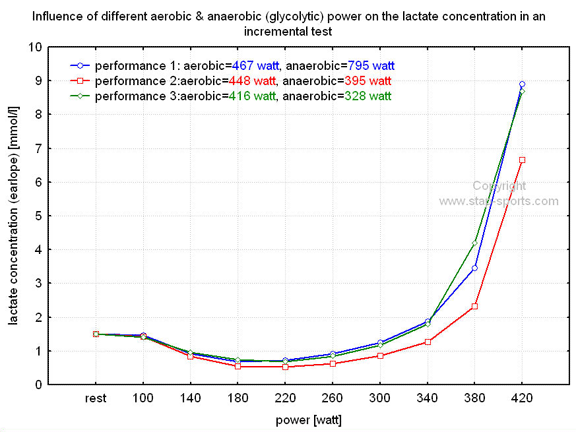
STAPS uses watts here to indicate the aerobic capacity in order to show how much power would be developed if the aerobic system were at full capacity. A similar measure is done with the anaerobic system. For cyclist 1 the 795 watts for the anaerobic system is only meant to show how much power could be produced by this system if the cyclist was able to fully utilize it. There is really no situation where the athlete can fully utilize this power but the measurement is used here so that one can get a feeling for the differences between the three cyclists in this system. However, Cyclist 1 will be a much better sprinter than the other two cyclists. In the chart above the anaerobic system was measured in mmol/l per second produced and not in watts.
It is important to understand generally what these measures mean physiologically but more importantly how they affect a cyclist's performance and that both the aerobic and anaerobic systems have to be trained to reach a peak performance. In other words the anaerobic system has to be trained just as the aerobic system has to be trained. Otherwise the cyclist will not reach his or her potential.
Here is an abstract from an article on STAPS ( Under Wissenschaft which means science click Methoden)
Translated from German
VLamax, the maximum lactate formation rate
The secret of endurance performance (- the professionals)
VLamax maximum lactate formation rate - the secret of professional athletes
In the context of conventional power diagnostic examinations the anaerobic threshold and the maximum oxygen intake is normally determined. Comparing the performances of professional athletes and amateur or recreational athletes, show significant differences: the anaerobic threshold of a 75kg professional cyclist is approximately 400 to 450 watts, which in an equally serious amateur, however, about 35% lower at only 300 watts. The maximum oxygen uptake is different in both types of athletes but only by about 10%. Thus, the 35% difference in the anaerobic threshold (= aerobic capacity) can not be explained by the difference in oxygen uptake.
What is different with professional athletes, or what needs to change the amateur athlete to make this difference smaller?
The reason for the difference between the very high endurance capacity of the professional athlete and the low power of the amateur is the difference in lactate production rates. The maximum lactate formation rate, is lower in the pros by about 175% as in recreational athletes. What are the consequences?
A high maximum lactate formation rate (VLamax) means that even at lower loads in endurance much lactate is always produced. Furthermore, increased consumption of carbohydrates during training and competition adds to this. Fat burning is also degraded when the lactate formation rate is high!
In the truly unique STAPS diagnostics the maximum lactate formation rate is measured very accurately. This provides you with exclusive knowledge of these important parameters so you can make your workouts more effective. Through targeted training, lactate production can reduce the carbohydrate consumption, improve fat burning and increase especially the performance of the anaerobic threshold significantly.
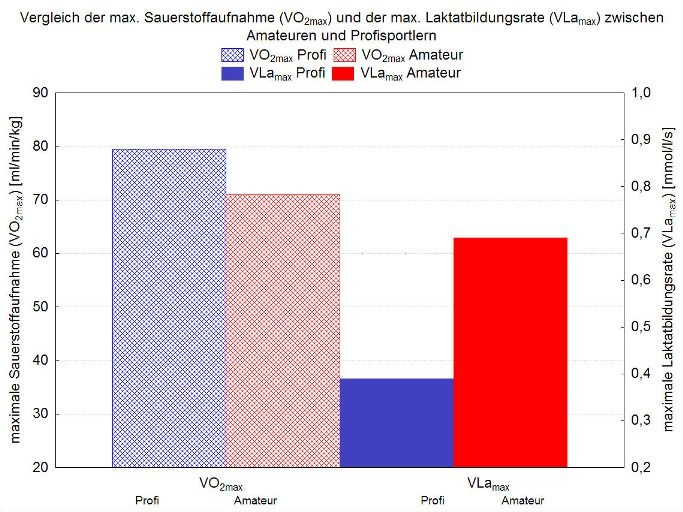
Basically this visual reinforces the chart from above in that the reason why some cyclists are amateur and recreational and others are able to compete nationally or internationally is that their anaerobic capacity is too high.
The STAPS website has been changed. This visual is from a previous version of the website:
- Since each athlete is different it is important to know how this profile is changing over time. This is the really important part of lactate testing. It documents what happens to each athlete. and when compared to the training they performed and the athletes performance in competition it enables the coach to know what works and doesn't work with each cyclist. Training starts to become more efficient as athletes only perform workouts that are effective. This individualized approach helps the athlete reach the perfect balance for their event. For example, Cyclist C in the example above might be better suited for track cycling.
The following is an example of a mountain biker who has been injured and whom Val Burke of Whistler in British Columbia was advising (Val now lives in New Zealand):
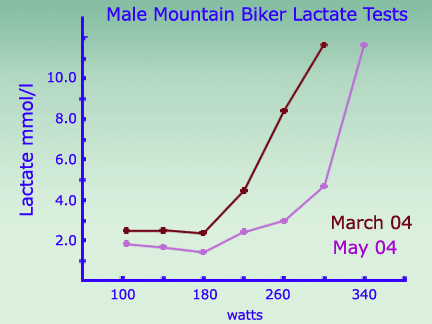
This male mountain biker was recovering from a knee reconstruction in January. Throughout January & February his rehabilitation included stationary cycling, and after he was tested in March he started riding outdoors. He averaged 12-15 hours of cycling per week, over half of it on the road. He was doing primarily aerobic miles, but his training included concentrated hill climbing 1x/week, and all his rides included elevation gains of a minimum of 600 m. His test demonstrated a very significant right shift to his lactate curve, a decrease in his heart rate over all the given power outputs; and he completed 340 Watts whereas he only completed 300 W during his previous test. These indicate a large increase in his cycling fitness - His training was working!!
Watts per kilogram - another way that top sports scientists measure fitness with cyclists is by watching the lactate levels at various watts per kg. The lower the lactate, the better conditioned the cyclist. Iñigo San Millán, one of the top cycling sports scientist in the world has done research on what can be expected from different levels of cyclists in terms of watts per kilogram. The results of Dr. San Millán's research are in the following table which appears in a paper he wrote.
Blood Lactate Levels by Different Levels of Cyclists
|
Workload |
Junior Cyclist |
Top Amateurs
|
Avg. Pro-Tour |
World Class |
|
w/kg
| La (mmol/L) |
La (mmol/L) |
La (mmol/L) |
La (mmol/L) |
|
3 |
1.3 |
1.1 |
1.1 |
0.8 |
|
3.5 |
1.8 |
1.3 |
1.2 |
0.8 |
|
4 |
3 |
2.3 |
2 |
0.96 |
|
4.5 |
6.6 |
3.5 |
3.2 |
1.8 |
|
5 |
10 |
7.6 |
5.8 |
3.1 |
|
5.5 |
|
9.2 |
8.2 |
5.2 |
|
6 |
|
|
|
8.9 |
Millán, I. S., et al. (2009). Physiological Differences Between Road Cyclists of Different Categories. A New Approach. American College of Sports Medicine, ACSM.
The cyclists were top junior cyclists, elite amateurs, UCI Pro Tour Professionals and cyclist who have been on the podium of the major European tours or world champions or winners of UCI Pro Tour league races.
Power Levels by Weight
Different Levels of Cyclists
|
Workload |
Junior Cyclist |
Top Amateurs
|
Avg. Pro-Tour |
World Class |
|
W Peak |
317 |
338 |
370 |
401 |
|
W Peak/kg |
4.91 |
5.09 |
5.27 |
6.1 |
This is another way for a cyclist to keep track of their progress. The chart below is just the plotting of Dr. San Millán's findings on a typical lactate curve. Where is your cyclist on the following chart?
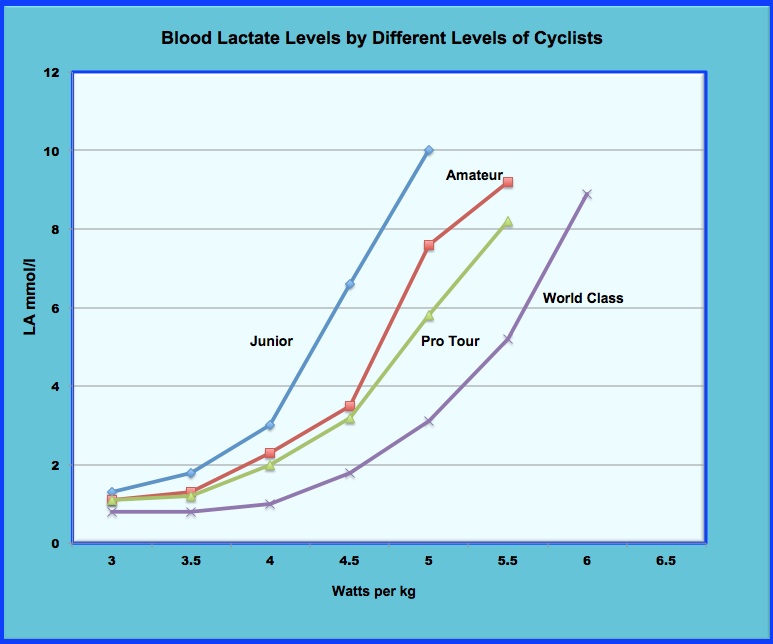
- A third purpose for testing is that the results will allow the coach to set individual training intensities for each type of workout. The following is the testing of a male triathlete by Jan Olbrecht. The cyclist completed 3 x 5500 m rides at sub-maximal paces. Each ride was progressively faster. After generating lactate levels above 4.0 mmol/l the athlete stopped and the curve below was generated.
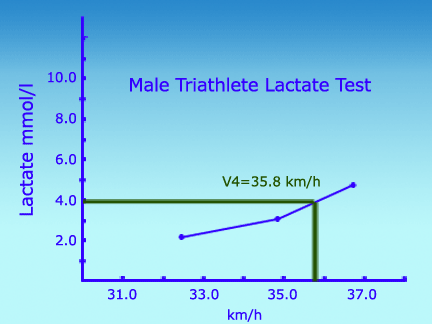
Jan Olbrecht did what is called a control test to estimate the anaerobic capacity of this athlete. He had the athlete get back on the trainer and do 3 sets of 5 x 1000 m rides at increasing intensities. Lactate values were taken after each set. The following chart lists the results:
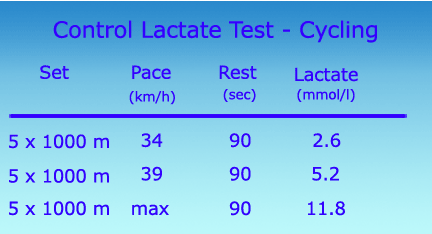
After performing both the step test and the control test, the athlete used the following chart to guide his training:
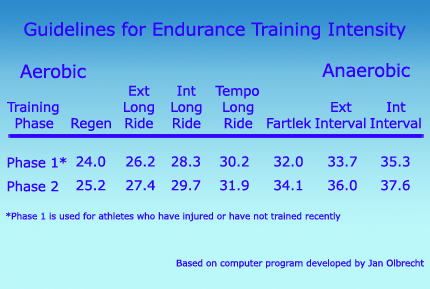
As an aside to this discussion which is about using lactate testing for training cyclists is a brief comment on training philosophy. The recommendation for this athlete was to do about 90-95% of his training in the column marked ext long ride. The evaluation of this athlete was that his aerobic endurance was not what it should be and the reason why is that he was doing too much of his training at the right hand side of this chart which was near or above the threshold. This type of training had the opposite effect of what the athlete had hoped for even though the training did not feel very hard. So in order to get faster, the athlete had to train slower
This example may seem quaint in the era of power meters but was from the late 1990's when coaches tested cyclists on outdoor courses, generally flat. Now nearly everything is done in doors using a power meter.
.
The information from Sebastian Weber and Jan Olbrecht are based on proprietary computer analysis. The preceding also assumes that the cyclist is using proper technique, has the proper mental attitudes for the race and is using good race strategy. All are extremely important for a top performance. But if these elements are equal among competitors (and they often are at high levels of competition) it means that the winners of the race will generally be the best conditioned cyclists. Weight is also an extremely important factor as lighter weight cyclists have an advantage in stages with substantial climbs.
Energy systems
Since the primary physiological objective is to maximize energy production per unit of time during a race the main focus by a coach should be the training of the body's energy systems. We mentioned that the cyclist mainly utilizes two energy systems during a race, the aerobic and anaerobic systems. There is a third energy system in the body, the creatine phosphate system, but this system plays a small role in a cycling race and is also not very trainable. This system is crucial for a high jumper or a 100 m runner but for a cycling race a coach can minimize the training of this system even for Olympic level athletes.
Aerobic system - The most important energy system for cyclists is the aerobic system. The aerobic system has two functions.
- The first is to provide energy. The more developed the aerobic system the more energy it can produce per unit of time (better aerobic capacity.) Because the end products of the aerobic system are water and carbon dioxide which are harmless, there is usually never enough aerobic capacity. That is, the higher the better. Optimal development is maximum development. The only time one would sacrifice aerobic capacity is if the development of it would interfere with the development of other characteristics necessary for a good performance. Most of the physiological training of a cyclist is directed toward raising aerobic capacity but aerobic energy alone is not enough to win a race especially if there is a sprint at the end.
- The second function of the aerobic system is to utilize the output of the anaerobic system. Unlike the aerobic system, the output of the anaerobic system, is definitely not harmless. The anaerobic system puts out lactate and hydrogen ions. If too many hydrogen ions accumulate in the muscles, energy production is slowed down and contraction impaired. (It is the hydrogen ions, not lactate, that causes the pain and other problems in the muscles.) The aerobic system actually utilizes these by-products for fuel. The stronger the aerobic system the less lactate and hydrogen ions will accumulate. Look again at the chart above on the time trial. During a large part of the race the cyclist was actually removing small amounts of lactate from the muscles by riding at a power level below the threshold. This prevented the lactate and hydrogen ions from accumulating to a high level and slowing down the cyclist.
A highly developed aerobic capacity enables the athlete to use the anaerobic system to a greater extent, therefore allowing the cyclist to sustain the speed necessary to win. This is especially important in short time trials but is important for longer races too especially if there is a sprint to win the race or stage.
Anaerobic system - This system is extremely important for success in cycling as we just commented with respect to sprints to win at the end of a stage or race. While this system provides less energy in total than the aerobic system, the energy it does produce is generated much faster. It is the source that allows the cyclist to accelerate when necessary for attacks, pursuits, up hill rides and sprints. It provides the top speed that wins close races. No one wins a cycling race with a poorly developed anaerobic system nor does anyone win a race such as a time trial without using it extensively.
- If the anaerobic system is too developed, the outputs (lactate and hydrogen ions) will overwhelm the aerobic system and accumulate rapidly in the muscles. Look at Cyclist C in the second chart above. The reason his threshold is much lower than Cyclist B is the strong anaerobic system he possesses. Thus, an anaerobic system that is too strong will actually force the cyclist to slow down and a produce less energy per unit of time during race. Unlike the aerobic system the level has to be carefully trained or "fine-tuned". Cyclist C will be a better road cyclist if he can lower his VLamax or increase his aerobic capacity. He actually may be a good sprinter at lower class races.
- If the anaerobic system is too weak, the athlete will not produce enough lactate to fuel the aerobic system. Aerobic energy can utilize either fats or carbohydrates. If little carbohydrates are produced by a weak anaerobic system, then the aerobic system is forced to use fats and fats metabolize much slower than carbohydrates. Thus, a weak anaerobic system will force the muscles to use a slower energy process.
The anaerobic system has to be carefully matched to the level of the aerobic system. The anaerobic system of an athlete is trainable just like the aerobic system but to a lesser extent. Many coaches do this without realizing that is what they are doing. It is possible to lower or raise the anaerobic capacity depending upon what is required for a peak performance. The proper level will depend upon the requirements of the race and the strength of the aerobic system. In general the stronger the aerobic system the stronger the anaerobic system can be and the longer the athlete will be able to utilize this faster energy system during a race. Coaches should be aware of this relationship since the balance between the two systems is what will determine the physiological performance of the athlete.
We have an animation of how changes in the aerobic and anaerobic systems affect swimming speed. This anaimation is on swimming but the same ideas will work on cycling. See animation here.
Interesting Research on Cyclists
At this point we would like to discuss a very interesting and well crafted research study from 1988 on good cyclists. It is extremely well done but there is one main thing wrong with it, namely some of the conclusions of the study. But first let's look at some of the findings.
What did this study find? This study took 14 cyclists with very similar VO2 max values and different threshold values. These two groups were designated as the high and low groups. They study then tried to find differences between the two groups to explain the different thresholds. A key finding of this study is that those with the lower threshold fatigued much sooner than those with the higher threshold at the same effort level. Obviously an important factor in a race.
Coyle, E. F., et al. (1988). "Determinants of endurance in well-trained cyclists." Journal of Applied Physiology 64(6): 2622-2630.
Lactate Threshold Differences
Cyclists
with same VO2 max
|
Group |
VO2 max l/min |
VO2 max ml/kg//min
|
% VO2 max at LT |
Time to fatigue-min |
|
High VO2 at LT |
4.87 |
68.6 |
81.5 |
60.8 |
|
Low VO2 at LT |
4.75 |
66.0 |
65.8 |
29.1 |
Next the study looked at fuel consumption or glycogen used in a 30 minutes ride at 79% of VO2 max, a pace that all could complete. The Low group consumed twice as much carbohydrates/glycogen as the High Group. In other words the Low group were utilizing the anaerobic system at a much higher rate than the High group. Yet they had similar VO2 maxes. Why? There was a fiber type difference which might explain this. It is interesting to note that those with more fast twitch fibers had the exact same VO2 max which means that the type II fibers(fast twitch) have similar oxidative capability.
Lactate Threshold Differences
Cyclists
with same VO2 max
|
Group |
LA after test
mmol/l |
Carbohydrates oxidized
mmol
|
glycogen used
mmol/kg |
Type 1 fibers
% |
Type 2 fibers
% |
|
High VO2 at LT |
2.8 |
358 |
27.9 |
66.7 |
33.3 |
|
Low VO2 at LT |
6.2 |
605 |
65.4 |
46.9 |
53.1 |
Here is the study's conclusions.
In conclusion, the present results indicate that individuals with a similar VO2 max can vary greatly in glycogen utilization and time to fatigue when cycling at the same work rate and percentage of VO2 max.
These differences in performance ability during high-intensity submaximal cycling are highly related (r = 0.96; P < 0.001) to a combination of lactate production (i.e., %VO2 max at LT) and muscle capillary density (e.g., lactic acid removal). Muscle mitochondrial activity, which can be a primary determinant of lactate production , was not different in groups L and H, nor was their blood lactate responses when running uphill.
The factors associated with a high %VO2 max at LT when cycling and performance ability were years of cycling experience and percent type I muscle fibers. It appears that intense cycle training performed for -5 yr compared with 2-3 yr promotes continued neurological and/or muscular adaptations that reduce muscle glycogenolysis specifically when cycling.
Notice some things in the above conclusion. Cyclists with a similar VO2 max have different thresholds. But they also exhibit other differences, such as glycogen utilization and higher lactate production. It also said that certain fiber types reduce lactate/pyruvate production.
article class="shadows_in_g">
Key finding of this study
An important finding of this study suggests that endurance during submaximal exercise is closely related to the factors that control muscle glycogenolysis* and blood lactate concentration.
A thought provoking comment from this study is
It is interesting to discuss the possible factors that contribute to the widely differing rates of glycogen utilization, lactate production, and exercise time to fatigue in these athletes when cycling.
So what are these factors? This web page is about the factors that affect performance in cycling. It will impact on how a coach assesses his athletes and how he plans training for the next training cycle.
There was some interest in metabolic causes by the researchers in this study but they missed a key potential source of the exc
*a technical term which essentially means the breakdown of glycogen to glucose which then breaks down to produce lactate.
Lactate Testing
Lactate is associated with each of the two energy systems. It is produced by the anaerobic system and used as a fuel for the aerobic system. A properly constructed test can assess the development of each system and enable the coach to find the right balance between the two systems. Training becomes much more efficient as the athlete performs only workouts that have the desired adaptations. This is why lactate testing is so important. No other inexpensive, easily measured physiological parameter provides the same information. Also the testing can be done in the same environment where the athlete trains. It can usually be done wherever and whenever you want, though measuring lactate is more difficult on the road than on a trainer. We know one coach who takes his cyclists out on a flat road and then drives his car at a fixed rate and the cyclists follow at fixed distance so they are essentially going the same speed as the car. After 5000 m the coach stops and gets every cyclist's lactate. The car and cyclists turn around and go 5000 m in the opposite direction at a faster speed. The following describes some different testing scenarios.
Tests of the aerobic system - For each cyclist, in general, the more developed the aerobic system becomes the lower the lactate will be at any given effort level. (However, read the discussion after the STAPS test above) Thus a test of the aerobic system is one that measures how fast one can go or how much power is produced before lactate starts to accumulate. Typically, a coach will ask a cyclist to do 1-4 steps of 5-6 minutes (each step increasing the intensity)and then measure blood lactate after each step. The testing will stop when the athlete generates a fixed level of lactate (the most frequently chosen level is 4 mmol/l of lactate.) Usually, the faster the cyclist can go or the more power generated before he or she generates this fixed level, the stronger the aerobic system is.
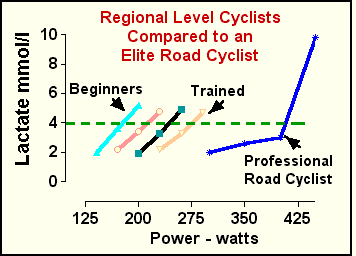
Notice that lactate starts to rise as the power increases. We use the place where the curve crosses the 4.0 mmol/l line as a reference point. In general the higher the power level or speed before the athlete reaches the 4.0 mmol/l line the higher the aerobic capacity of the athlete. (But remember our two examples from STAPS above where this was not true.) This is why knowing the VLamax is also extremely important. The power or pace where the line crosses the 4.0 mmol/l line is called the V4 pace or power (V4 or velocity at 4.0 mmol/l). If the coach prefers to use 3 mmol/l or 3.5 mmol/l as the fixed lactate level to compare athletes then V3 or V3.5 would be used. V4 is the most common standard but there is nothing magic about it .
The chart below shows how a coach can use a lactate test to calculate the V4 for a road cyclist. The V4 is 9.35 m/s. The anaerobic test based on a 60 second all out test. The cyclist generated 9.6 mmol/l lactate after this test. This is a fairly low number and indicates a low to moderate VLamax. This type of test can not be used to generate the specific VLamax numbers we saw in the STAPS charts above. The VLamax numbers can only be generated by a simulation program using a model of energy metabolism. However, this simpler approach can provide an approximation of the strength of the anaerobic system.
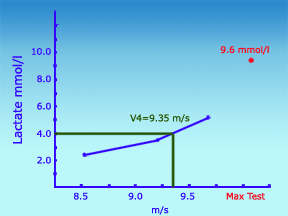
Here is the same chart but using km/h instead of m/s.
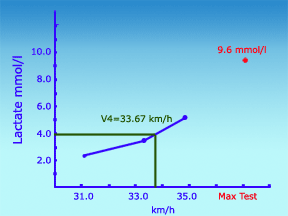
This may be easier to relate to since this is what many cyclists use while on the road and is what is reported for many cycling events such as the Tour de France.
Since most cyclists use power meters on their bikes or on their trainers, they may prefer the test be done in watts. Here is a different cyclist using watts in his lactate test.
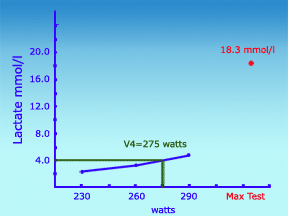
If you go to the mountain bike example above you will see examples of someone using a somewhat different approach. Val Burke trains age group cyclists and triathletes and uses a multi-step test to exhaustion. This test will often use 6-8 steps with the final step being when the cyclist cannot continue or is at exhaustion.
Comments about tests of the anaerobic system - The more developed the anaerobic system the more lactate it will produce and the faster lactate may accumulate. Thus a test of the anaerobic system is one that measures the maximum amount of lactate that is produced during a short test. The effort has to be maximal and short.
- Maximal; otherwise the anaerobic system is not being utilized to its maximum potential and any reading will underestimate anaerobic capacity.
- Short; because the amount of lactate accumulated after a long test will be affected by the strength of the aerobic system and because the effort level of the athlete should not be impaired by the discomfort of a long highly intense effort. The test cannot be too short however, or else the effort is influenced too heavily by the creatine phosphate system.
The protocol we recommend for testing the anaerobic system for cyclists is a 30-50 second all out test. The maximum amount of lactate generated after such a test is correlated with the development of the anaerobic system. Here are three examples:
All Out - Lactate Test
Triathletes
|
Level of Triathlete |
Male/ female |
La (mmol/L)
|
Test |
|
Recreational |
m |
13.6 |
50 s indoor |
|
Serious |
f |
5.3 |
600 m outdoor |
|
World Class |
m |
9.4 |
1000 m outdoor |
|
World Class |
m |
8.4 |
600 m outdoor |
The test on the recreational athlete test was done indoors and indicated that he has a strong anaerobic capacity and if he wanted to get better in the triathlon, then he would have to train to suppress this capacity before a race.
The serious triathlete had close to world class tests on her V4 test but in actual competitions was not close to the times expected of this test. The anaerobic test explained why. She was put on a training plan that included efforts to raise her anaerobic capacity, while lowering the intensity of her other workouts. Why lower the non anaerobic work? Because her test falsely indicated a higher aerobic capacity than she possessed.
The two world class triathletes had lactate reading that were in range of what was expected and no special attention had to be paid to the training of this system for upcoming races or training.
These tests are probably a little too long and should tend to be around 30 seconds.
The importance of this test is two fold. First, the measure of anaerobic capacity helps the coach balance the two systems for an optimal performance and second the level of the anaerobic capacity affects the reading of the aerobic endurance test (see serious triathlete above.) If the coach or athlete does not have some idea of the strength of the anaerobic system then they may misjudge the type of training that is necessary to increase the athlete's performance level in competition.
Interaction of the aerobic and anaerobic systems - We mentioned above that before a coach can make an accurate assessment of the aerobic system he/she must have a measure of the anaerobic system. The reason for this is that a strong anaerobic system will generate much higher levels of lactate than a weak one. Thus, coaches who perform the aerobic test described above will not know how much aerobic capacity a test is measuring unless they also have a measure of the anaerobic system. Two cyclists with identical measures on the aerobic test could have very different aerobic capacities because their anaerobic systems are producing different amounts of lactate. This was illustrated in the STAPS example above.
Both Sebastian Weber of STAPS and Jan Olbrecht have proprietary methods of measuring the anaerobic capacity of an athlete. Their measures are more precise than the test we have recommended. But every coach should take into account the effect of anaerobic capacity even if all they do is the simple test we recommend. Also in his book, The Science of Winning, Jan Olbrecht provides some subjective ways to estimate anaerobic capacity for swimmers which may have some applicability for cyclists.
Summary
The goal of the many hours of training is to optimize the two energy systems. When one knows how muscles react during exercise and how the aerobic and anaerobic capacity adapt to training, the coach will know what and how to train. This increases training efficiency while decreasing the risk of over-training and injuries.
You will notice that we have not emphasized the concept of lactate threshold or anaerobic threshold or lactate clearance or lactate tolerance. We don't believe they are that important for training. We also have only touched the surface of this topic. Those who want to know more should read the Lactate Tutorial on our Secrets of Lactate CD-ROM.
Acknowledgement
We want to especially thank Dr. Jan Olbrecht for his advice on the original preparation of this document. His insight into the interaction of the two energy systems and the physiology behind a peak performance has led us down an innovative path on how to advise coaches and sports scientists on the use of lactate testing. He first developed these ideas as a student of Alois Mader at the German Sports University in Cologne. He is a "Maestro".
We also want to thank Sebastian Weber of STAPS who is also a graduate from the German Sports University in Cologne and has used similar ideas first developed by Dr. Mader but applied to cyclists. At the time we first published this in 2005, Sebastian was working with two cyclists in the 2005 Tour de France.
He has been a coach of more than one cycling team HTC-Columbia and Cannondale. There was a published interview about his HTC-Columbia experiences. This has been taken down from the internet but here are parts of it.
Mark Cavendish and André Greipel, the dominating sprinters of 2009, are both on the same team - Team HTC Columbia. For you as an exercise physiologist and coach this must be a highlight!
Yes, of course. It is really exciting to have the opportunity to work with these athletes, and also the "sprint train". This is especially interesting as an exercise physiologist.
The combination of lab testing and power measurement in races has provided a huge amount of important information about the abilities and demands of lead out riders.
Do you use specific tests in preparation and race season to document the progress in training and use it for further planning? What are the tests? Do you also use these tests for other cyclists who visit STAPS for advice and supervision?
There are two kinds of tests I work with. There are the field tests and race data. They show the physical abilities of the athletes. But the information does not show how the performance has been accomplished. This is why we perform the lab tests at STAPS (www.staps-online.com). The three metabolic pathways are tested separately.
Most interesting for sprinters is the VLamax (the maximum anaerobic lactate power) and the size of the creatinephosphate capacity (anaerobic capacity). The way we test this is unique and in my opinion very important for effective planning.
For example: if a lead out rider in the sprint train is able to perform 900 watts for 30 seconds and after six weeks of training still performs the same 900 watts it is still possible that the energetic pathway has changed and therefore his performance has changed. This is important for further progressive training and this is where STAPS testing exactly monitors the changes.
The tests are the same for recreational athletes who visit STAPS and want to increase their anaerobic threshold or their fat metabolism.
What is the difference in the training that Greipel and Cavendish do? Do you think there can be a further progression for both?
I really think both can improve further. Mark has shown his progression in his endurance, and also in the race results. Let's have a look at Milan-San Remo last year, where the final in the last mountains was fast and Mark was still able to follow.
André also improved his endurance in recent years, and despite his huge muscles he climbs pretty well. The best example is his victory at Tour Down Under. In 2008 they had to climb Willunga Hill only once, this year twice - and his opponents tried everything to leave him behind. With the help of a strong team André was able to pass the mountain fast enough to defend the leader's jersey.
Is there a general difference in training for sprinters compared to other riders?
Well, there are some aspects that are different. Sprinters have specific training for speed skills and sprint abilities. These are all kinds of sprints, specific intervals and motorpacing. The amount of muscular endurance training is low because medium term this has a negative effect on liveliness.
How big is the influence of talent and training on the performance of a sprinter?
Basic physical and psychological abilities have to be there. Then training can lead to perfection. Sprinters in road cycling are "hybrids" because in contrast to 100m runners they need a high endurance level. Combining both is what makes it so interesting and demanding in planning their training.













